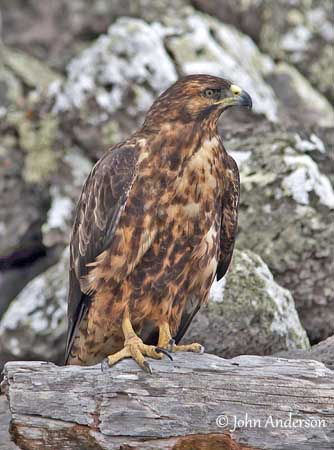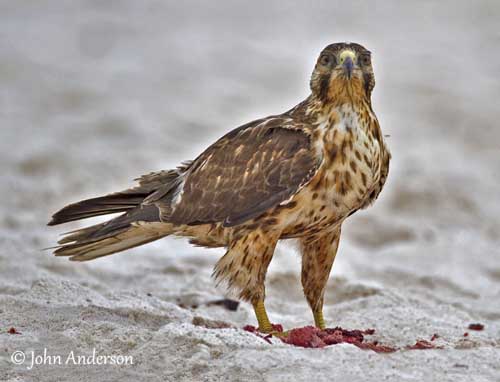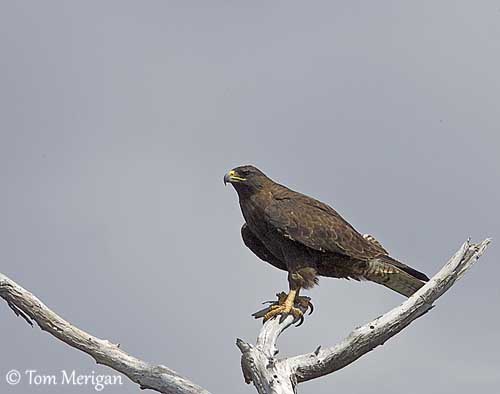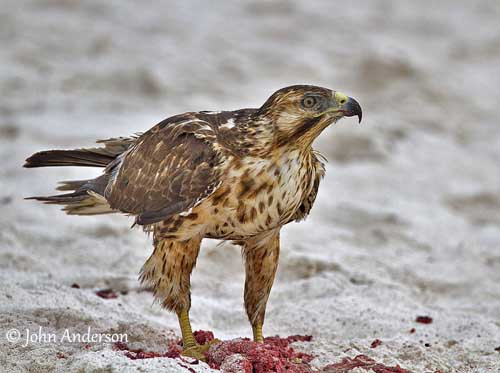
Fr: Buse des Galápagos
All : Galapagosbussard
Esp : Busardo de Galápagos
Ital : Poiana delle Galapagos
Nd: Galápagosbuizerd
Sd: Galapagosvråk
Photographers:
John Anderson
John Anderson Photo Galleries
Tom Merigan
Tom Merigan’s Photo Galleries
Text by Nicole Bouglouan
Sources:
HANDBOOK OF THE BIRDS OF THE WORLD Vol 2 by Josep del Hoyo-Andrew Elliot-Jordi Sargatal - Lynx Edicions - ISBN: 8487334156
BirdLife International (BirdLife International)
Animal Diversity Web (University of Michigan Museum of Zoology)
SORA Searchable Ornithological Research Archive (Blair O. Wolf)
Galapagos Hawk
Buteo galapagoensis
Accipitriforme Order – Accipitridae Family
BIOMETRICS:
Length: 55 cm
Wingspan: 120 cm
DESCRIPTION:
The Galapagos Hawk is living in reduced range on Galapagos Islands, and the species is extinct on several islands.
The adult has sooty brown plumage overall. On the upperparts, the mantle shows pale-edged feathers. The grey tail coverts are barred white. The uppertail is pale grey with several (about ten) narrow dark bars. On the wings, the flight feathers show paler inner webs and are barred white.
On the underparts, both undertail and underwing show dark, barred white rectrices and flight feathers. The underwing-coverts are dark brown. Flanks and lower belly have weak rufous-edged feathers.
On the head, the crown is usually darker than the body. The hooked bill is blackish with yellow cere. The eyes are dark brown. Legs and feet are yellow.
Both sexes are similar in plumage, but female is larger than male.

The juvenile has dark brown upperparts mottled white and buff. The underparts are pale buff and heavily spotted blackish brown. On the head, the crown is dark brown and the face is pale buff. We can see a dark brown malar stripe.
The bill is black with blue-grey base, and the cere is pale greenish-yellow. The eyes are pale greyish-brown. Legs and feet are dull yellow.

VOICE:
The Galapagos Hawk gives series of short screams “keer-keeu”.
We can occasionally hear a rapid “cher, cher, cher” and when in flight, it utters several screams produced in bursts of three to five.
This species is very noisy, but during the breeding season, it produces softer “kilp kilp kilp” notes.
HABITAT:
The Galapagos Hawk can be found in all types of habitats on the islands, from the shoreline through open areas, closed deciduous forest and mountain peaks, to barren lava fields. However, it nests only in dry areas.
RANGE:
The Galapagos Hawk is found on Galapagos Islands, but only on some islands such as Santiago, Española, Isabela, Fernandina, Pinta, Marchena, Pinzón and Santa Fe.
BEHAVIOUR:
The Galapagos Hawk is the only diurnal raptor of these islands, and it feeds on wide variety of preys, primarily on rodents, mainly indigenous species but also introduced rats. Ground Doves and Lava Lizards (Microlophus albemariensis) are added to its diet.
But it catches numerous passerines such as Finches and Mockingbirds, young seabirds at nesting colonies, young goats (introduced in the 19th century) marine and terrestrial iguanas, lava lizards, snakes, hatchling tortoises and sea turtles, large insects such as locusts, giant centipedes, caterpillars and carrion, including seal placentas.
It remains near the nesting areas of Swallow-tailed Gull to steal eggs and chicks.

The Galapagos Hawk usually hunts in small groups with a dominant female and several males. This hierarchy allows the female to feed first. They fly at height of 50-200 metres from the ground, and perform glides and sometimes hovering.
They are usually seen perched on high branches or on lava or rocky outcrops, and sometimes on the ground.
The breeding season is not well defined, and the Galapagos Hawk breeds at various periods of the year. The displays start with aerobatics by males and fake attacks to the female by dive-bombing from behind. If she accepts these displays, she descends to a tree below while using fluttering flight. The male follows her and the copulation occurs, often on a very low branch.
In this species, one female typically mates with two males or more, and all males take part in nesting duties. Each territory includes a small group which has an unusual polyandrous mating system.
During the nesting period, the female remains at nest with the brood, waiting for the preys caught by all males. These extra-males, usually one to three, but sometimes up to seven or height, take part in copulation, incubation, feeding of chicks and young, and defence of the territory. Such groups appear stable, remaining in territory year after year. However, some females breed with only one male.
This species is sedentary in its range on Galapagos Islands.

FLIGHT:
The Galapagos Hawk has broad wings and tail allowing it to soar around the islands. Courtship displays are a beautiful show of aerobatics, but after copulation, the male flies slowly and low from the ground.
REPRODUCTION:
The Galapagos Hawk breeds throughout the year.
The nest is made with sticks and lined with various plant materials such as grass, leaves and bark. Nest materials are added continuously to the nest during the cycle.
They use the same nest year after year, and the structure may reach great size, about 80-100 cm wide and up to three metres deep. It is placed on prominent site allowing a good view of the territory, usually in low tree or rocky outcrop, even on protruding lava outflow.
This species has a polyandrous mating system, with one female and several males. (See above in BEHAVIOUR).

The female lays 1-3 eggs. The incubation by all members of the group lasts 37-38 days. The young are fed by all adults, but usually, only one chick survives.
It fledges 50-60 days after hatching, once fully feathered. It leaves the territory within 3-4 months of fledging, and it will spend 2-3 years away from the breeding areas. It will be sexually mature at three years old.
DIET:
The Galapagos Hawk feeds on wide variety of prey items caught after a flight at about 50-200 metres from the ground. Preys are birds, reptiles, rodents and carrion, carcasses and seal placentas.
They hunt in groups in which the female is dominant.
PROTECTION / THREATS / STATUS:
The Galapagos Hawk suffered heavy persecution by settlers, considering this raptor a pest for poultry and livestock. The range is today greatly reduced and the species disappeared from five islands.
This is a rare bird with only 270-330 mature birds.
The Galapagos Hawk is listed as Vulnerable by BirdLife International.
